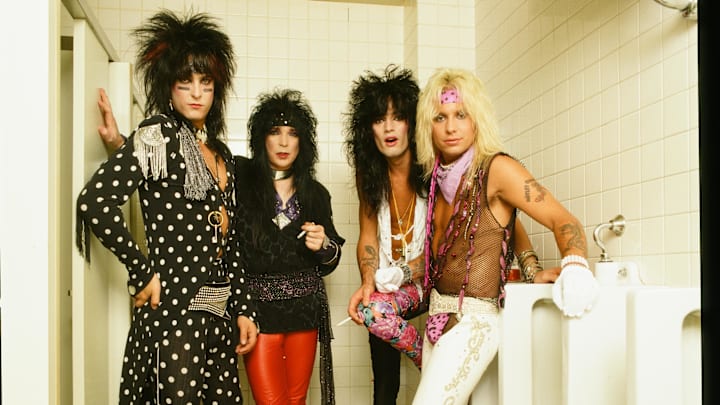For Mötley Crüe, inspiration struck—as it often does—while under the influence.
It was the early 1980s, and bandmates Vince Neil, Tommy Lee, and Nikki Sixx were imbibing Löwenbräu beer, a German beverage. The umlauts in the name seemed to strike a chord with them.
“I can remember it like it was yesterday,” Neil told Vanity Fair in 2009. “We were drinking Löwenbräu, and when we decided to call ourselves Mötley Crüe, we put some umlauts in there because we thought it made us look European. We had no idea that it was a pronunciation thing.”
They quickly found out. “When we finally went to Germany, the crowds were chanting, ‘Mutley Cruh! Mutley Cruh!’ We couldn’t figure out why the f**k they were doing that.”
Crüe, Blue Öyster Cult, Motörhead: For rock musicians, the umlaut has become a strange signature, one that seems to exist for no other reason than because it looks cool. (In fairness, that’s a prerequisite for pretty much everything in rock music, from hair bands to microphone stand scarves.) But while Neil and company may have helped popularize the punctuational accessory, they weren’t the innovators. The real story of the umlaut begins decades prior, in a decidedly less debauched German music scene. A commune, actually.

Though it had been around since the Middle Ages, the umlaut was named by Grimm brother Jacob Grimm, one half of the morbid storytelling duo. In 1819, he described um (around) and laut (sound) as a way to indicate how one vowel could influence another when spoken aloud. It was indicated by two dots above the vowel, which should direct the speaker to make an oo-ee sound. (Try saying oo-ee repeatedly, freeze your tongue on the ee, and then move your lips back to oo. It should sound a little like a banjo.)
Although it served a utilitarian purpose, the umlaut had another benefit: It was exotic-looking in print, especially with non-German speakers. That might have been one reason why German art commune Amon Düül opted for a double umlaut. According to Rolling Stone, their 1969 album, Psychedelic Underground, was the first to feature the mark on an album cover. (Some also credit the band with ushering in the krautrock genre, though the group hasn’t always received high praise. One reviewer dubbed their third album, Disaster, as “appropriately titled.” Nor should they be confused for the reportedly superior band, Amon Düül II.)
That a German band would commandeer the umlaut isn’t so unusual. What made it hit the mainstream in America was Blue Öyster Cult. The band adopted the style in 1971 after several other band names—Soft White Underbelly and Travesty among them—didn’t seem to resonate with fans. The Cult did, especially when it merged with the umlaut, the result of band manager Sandy Pearlman and rock writer Richard Meltzer standing outside a restaurant serving Blue Point oysters.
“I said, ‘Why don’t we call it Blue Oyster Cult?’” Pearlman told Rolling Stone. “And Richard said, ‘And we’ll add an umlaut over the O!’ And I said, ‘Great!’”
The band agreed. “I think the umlaut had a bit of tongue-in-cheek humor about it,” founder Eric Bloom said in 2013. “Plus it made the band’s name look cool in a way.”
(Oddly, some proclaimed BOC favored neo-Nazi sentiments, owing in part to the umlaut and to a German plane on the cover of their Secret Treaties album. Both Bloom and Pearlman are Jewish.)

The success of Blue Öyster Cult led to some copycat umlaut insertions. Lemmy Kilmister, the leader of rock band Motörhead, has said he took a cue from the Cult when naming his own group. Kilmister was not a grammar aficionado; he just thought the umlaut looked appropriately fierce for his aggressive style of music. (It should be noted that Kilmister also collected Nazi memorabilia, which somewhat colors his commandeering of German punctuation. Kilmister, who died in 2015, denied having any racist beliefs.)
“I pinched the idea off Blue Öyster Cult,” he said. “Then Mötley Crüe pinched it off us and it goes on and on.”
Before long, the umlaut could not be stopped. Minneapolis band Husker Dü followed; so did Queensrÿche; Jay-Z used Jaÿ-Z for a 1996 album, Reasonable Doubt; Canadian band Voivod titled their 1986 record Rrröööaaarrr, probably ironically; the Guitar Hero video game series introduced heavy metal rocker Lars Ümlaüt.
The cherry atop the umlaut pile may be faux British rockers Spın̈al Tap, the subject of the 1984 mockumentary This Is Spın̈al Tap, which removes the dot over the I and places the umlaut nonsensically over the N. Then again, if the umlaut’s only purpose in rock is to look cool, there’s nothing wrong with that.
